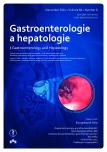OVESCO clip as a solution of an ERCP complication
Authors:
M. Wasserbauer; J. Lochmannová; R. Keil
Authors‘ workplace:
Interní klinika 2. LF UK a FN v Motole, Praha
Published in:
Gastroent Hepatol 2014; 68(6): 485-487
Category:
Digestive Endoscopy: Case Report
doi:
https://doi.org/10.14735/amgh2014485
Overview
Endoscopic retrograde cholangiopancreatography is an endoscopic technique which nowadays plays an irreplaceable role in the diagnostics and mainly in the therapy of diseases of the biliary system and pancreas. Despite its unquestionable benefits, ERCP is a mini-invasive, highly specialized method with a risk of very serious complications. Possible complications after therapeutic ERCP include perforation events. Although these complications are certainly not the most common ones, they seriously threaten the patient's life. In our case report, we describe the origin of a perforation event after therapeutic ERCP, when the duodeno-biliary drainage (in a patient with stenosis of the bile duct) left the bile duct and perforated the small intestine. We treated the perforation using the OVESCO clip immediately after recognizing it and thereby solved the situation.
Key words:
endoscopic retrograde cholangiopancreatography – biliary drainage – intestinal perforation – clip
The authors declare they have no potential conflicts of interest concerning drugs, products, or services used in the study.
The Editorial Board declares that the manuscript met the ICMJE „uniform requirements“ for biomedical papers.
Submitted:
29. 7. 2014
Accepted:
8. 9. 2014
Sources
1. Andriulli A, Loperfido S, Napolitano G et al. Incidence rates of post-ERCP complications: a systematic survey of prospective studies. Am J Gastroenterol 2007; 102(8): 1781–1788.
2. Cotton PB, Lehman G, Vennes J et al. Endoscopic sphincterotomy complications and their management: an attempt at consensus. Gastrointest Endosc 1991; 37(3): 383–393.
3. Canard JM, Letard JC, Pallazo L et al. Gastrointestinal endoscopy in practice. London: Churchill Livingstone 2011: 84–100.
4. Bagul A, Pollard C, Dennison AR et al. A review of problems following insertion of biliary stents illustrated by an unusual complication. Ann R Coll Surg Engl 2010; 92(4): W27–W31. doi: 10.1308/147870810X12659688852239.
5. Arhan M, Odemis B, Parlak E et al. Migration of biliary plastic stents: experience of a tertiary center. Surg Endosc 2009; 23(4): 769–775. doi: 10.1007/s00464-008-0067-x.
6. Fatima J, Baron TH, Topazian MD et al. Pancreaticobiliary and duodenal perforations after periampullary endoscopic procedures: diagnosis and management. Arch Surg 2007; 142(5): 448–454.
7. Kuhlman JE, Fishman EK, Milligan FD et al. Complications of endoscopic retrograde sphincterotomy: computed tomographic evaluation. Gastrointest Radiol 1989; 14(2): 127–132.
8. Enns R, Eloubeidi MA, Mergener K et al. ERCP-related perforations: risk factors and management. Endoscopy 2002; 34(4): 293–298.
9. Howard TJ, Tan T, Lehman GA et al. Classification and management of perforations complicating endoscopic sphincterotomy. Surgery 1999; 126(4): 658–663.
10. Stapfer M, Selby RR, Stain SC et al. Management of duodenal perforation after endoscopic retrograde cholangiopancreatography and sphincterotomy. Ann Surg 2000; 232(2): 191–198.
11. Lee TH, Han JH, Park SH. Endoscopic treatments of endoscopic retrograde cholangiopancreatography – related duodenal perforations. Clin Endosc 2013; 46(5): 522–528. doi: 10.5946/ce.2013.46.5.522.
12. Weiland T, Fehlker M, Gottwald T et al. Performance of the OTSC System in the endoscopic closure of iatrogenic gastrointestinal perforations: a systematic review. Surg Endosc 2013; 27(7): 2258–2274. doi: 10.1007/s00464-012-2754-x.
13. Hagel AF, Naegel A, Lindner AS et al. Over-the-scope clip application yields a high rate of closure in gastrointestinal perforations and may reduce emergency surgery. J Gastrointest Surg 2012; 16(11): 2132–2138. doi: 10.1007/s11605-012-1983-6.
Labels
Paediatric gastroenterology Gastroenterology and hepatology SurgeryArticle was published in
Gastroenterology and Hepatology

2014 Issue 6
Most read in this issue
- OVESCO clip as a solution of an ERCP complication
- An infrequent source of gastrointestinal bleeding
- Karlovy Vary gastroenterological – this year for the thirteenth time
- Vedolizumab – a novel anti-integrin antibody with high gastrointestinal selectivity
